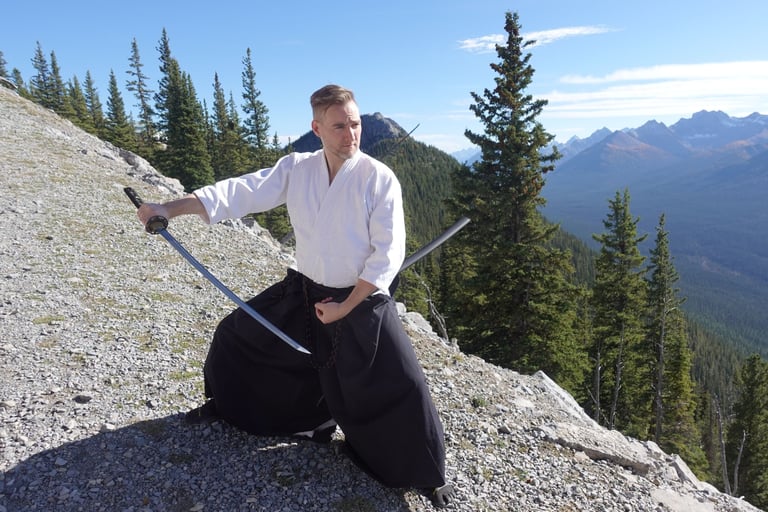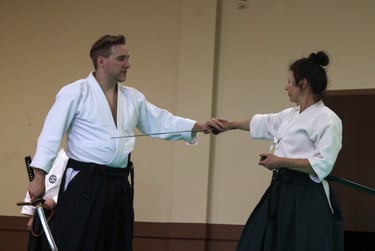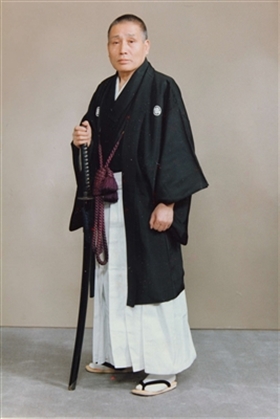Mugenshintō Ryū Iaijutsu
At Calgary Rakushinkan, we practice Mugenshintō Ryū Iaijutsu, a Japanese sword art with deep roots in the Aizu domain traditions. The style was shaped by Takeda Sōkaku—famous for Daitō Ryū Aikijūjutsu—and codified by his disciple Yamamoto Ittōsai Kakuyoshi. Mugenshintō Ryū blends the precision of iaido, the combative realism of kenjutsu, and the body skills of taijutsu into a single, integrated system.
Why We Practice It
We train Mugenshintō Ryū because it preserves authentic combative principles rarely found in modern martial arts. Practice is not limited to form—each movement is studied for its timing, distance, and effectiveness under real conditions. The same principles of spacing, posture, and body control developed through the sword directly enhance our aikido and other budō training.
Benefits for Students
Refined awareness of distance and timing
Improved body mechanics through coordinated posture, breathing, and movement
Sharper decision-making by learning when to move, cut, or remain still
Connection to history via a direct lineage from pre-modern Japan
Integration with aikido—sword principles reinforce unarmed technique
For us, Mugenshintō Ryū is more than a sword art—it is a living tradition that strengthens both the body and the mind, and deepens our understanding of the spirit of budō.






Founder: Yamamoto Kakuyoshi
Yamamoto Kakuyoshi received from Takeda Sōkaku:
July 1941: appointment as Kyōju Dairi (teaching representative, recorded in the Eimeiroku)
May 1942: transmission of the Daitō-ryū Aiki-jūjutsu Hiden Ōgi no Koto (Great License, Menjō)
At that time, he was entrusted with the title of Daitō-ryū head (sōshu), and was given the characters “Kaku” (角) from Sōkaku’s name and “Yoshi” (義) from his alternate name, Minamoto Masayoshi, thus permitted to take the name Yamamoto Kakuyoshi. He also received a purple haori cord and a sword (tachi, attributed to Yukihira) that had been bestowed upon the Takeda family by Aizu lord Matsudaira Katamori.
After Sōkaku’s death, Yamamoto, applying originality to the tegatana (hand-sword) of Daitō-ryū, and bringing together the Ono-ha Ittō-ryū kenjutsu and Shintō Seiburyū traditions he had learned, created a new iai system embodying the principle of ken-jū ittai. He named this art Mugenshintō-ryū Iaijutsu, and since that time he and his successors have borne the name “Ittōsai.”


山本角義先生
Yamamoto Kakuyoshi Sensei
Characteristics of the Art
Because Mugenshintō-ryū was created as an iai expressing the unity of sword and jūjutsu, it differs from modern kendō postures (parallel footwork). Instead, it incorporates the Daitō-ryū body movements, such as shumoku-ashi (bell-hammer stepping), and emphasizes techniques that control the opponent by constantly taking their movement into account.
The curriculum is divided into:
Shoden (Initial transmission): 13 seated techniques (zawaza)
Chūden (Middle transmission): 11 half-standing techniques (han-tachiwaza)
Okuden (Inner transmission): 17 standing techniques (tachiwaza)
Additional sets: 12 methods including taitō taijutsu (body arts while wearing the sword) and practical cutting methods (zanpō jitsugi)
Only those who also train in Daitō-ryū Aiki-jūjutsu can grasp its deepest essence.
Recognition and Later Development
In 1977, at the request of the Nihon Kobudō Shinkōkai (Japan Classical Martial Arts Promotion Society), Mugenshintō-ryū was formally admitted to the association. At that time Yamamoto Kakuyoshi developed close friendships with masters of other arts, such as Ōtsubo Shikata of Shinkage-ryū, Mutō Masao of Yagyū Shingan-ryū Taijutsu, Ōtsuka Hiromasa of Wadō-ryū Karate-dō, Saitō Satoshi of Negishi-ryū Shurikenjutsu, and Sugano Hisashi of Makage-ryū Jūjutsu.
Under Yamamoto Kakuyoshi, Mugenshintō-ryū also included Ono-ha Ittō-ryū kenjutsu and bōjutsu as parallel teachings. From the time of Nagaō Zen’yū onward, the Ono-ha Ittō-ryū was reorganized as an independent system, and today we preserve and teach three traditions in parallel:
Daitō-ryū Aiki-jūjutsu (Yamamoto lineage)
Mugenshintō-ryū Iaijutsu
Ono-ha Ittō-ryū Kenjutsu (Aizu transmission)
Calgary Rakushinkan
カルガリー楽心館
Experience traditional Japanese martial arts training.
© 2025. All rights reserved.
CONTACT
rakushincalgary@gmail.com
(403) 401-8257
